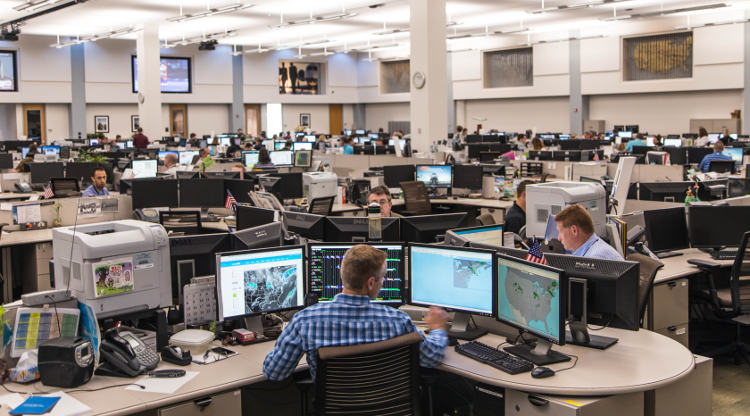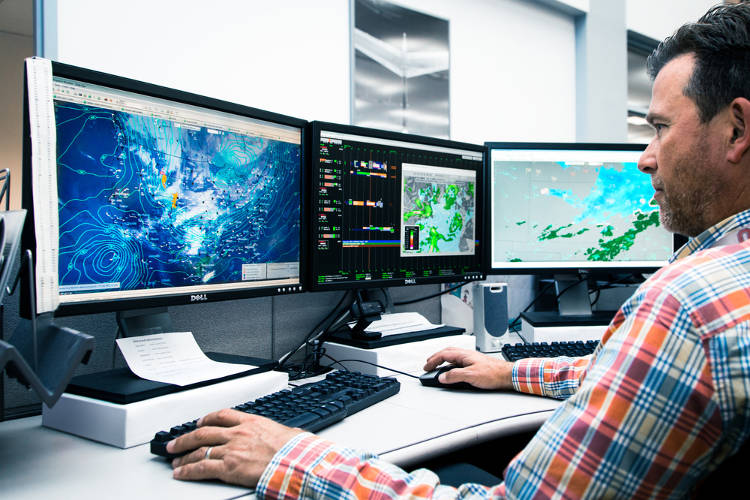SherpaReport visited NetJets headquarters in Columbus last month and had the opportunity to tour the Flight Center and meet several of the management team. I obtained great insights into the operations and how NetJets matches its aircraft and crews to the needs of its owners. Here’s what I learned.

Flight Center
The NetJets Flight Center is the beating heart of the whole NetJets operation in North America. It’s one massive open room that contains dispatchers, meteorologists, owner services, and several other teams of NetJets staff, who all work together to ensure the NetJets fleet gets people where they want to go.
It’s only when you step into a room like this that you start to appreciate the complexity of the NetJets operations. Compared to commercial flying there are just so many more variables that can affect what’s happening from day to day. For instance, American Airlines, as a commercial airline, knows several months in advance which routes its planes are flying and has time to plan which actual aircraft and crews will be operating on each of these routes.
But with NetJets, all this can change from hour to hour. A NetJets owner could call in and request a plane with as little as 4 hours’ notice, and NetJets will get a plane and crew to them and takes them wherever they want to go. NetJets has 7,000 fractional owners and jet card holders, so that’s a lot of people who could ask for a flight at any moment.
As you start to consider all the variables that can affect this efficient operation ...... things like having a plane available, having the right trained crew available for that plane, all the stuff in the air the obvious one being the weather, all the things that can happen on the ground ........ you realize that there’s an enormously complex system and operation that makes this all work smoothly.
NetJets has built custom software and systems to run this whole operation. Known as IntelliJet, the system manages all reservations and flight-tracking. On a typical day, NetJets may have 350 to 375 customer flights and on the busiest days, such as the Sunday after Thanksgiving, there could be 650 to 700 flights plus all of the repositioning flights in between. So, there’s a lot to manage.
Owner Services
The owner services group is the first point of call for NetJets customers. This group builds a picture of the likes, dislikes, and preferences for each of their customers. Rich Wrona, VP Service Experience, explained to me that the detailed record of customers preferences is updated all the time, by customer service staff, sales staff and even by aircraft crew members, all helping to create a full profile of each owner.
Rich went on to describe how each owner has their own phone number to call in to, which goes to their dedicated service team. If the owner has called in over the last few days, NetJets can send the call to the same person they’ve been communicating with, providing consistency and familiarity for each call.
The owner records include preferences for newspapers, food, wine, beer, soda and even the amount of cream that someone likes in their coffee. The idea is to create the feeling that it’s their aircraft so that when the owner steps onboard the plane, they get the true ownership feeling. Or, as another personalization example, NetJets will change their communication method at weekends, when an owner is at home, compared to during the week when they are in the office – it all depends on what the owner wants.
One NetJets owner trusted their NetJets owner services team so much that they called them when their rental car broke down in the middle of Pennsylvania. In other words, rather than calling the car rental company, they had more faith in NetJets owner services to sort them out and provide help – which NetJets were able to do.
Steve Frazier, VP Owner Services noted that there are 200 people in the owner services group, who are purely there to help the owners and card holders. These owner services staff receive six weeks of training before they start to answer the phone and talk to owners. Three weeks of this training is in the classroom and three weeks involves mentoring in the flight center.
Customer service training covers things like ordering food. NetJets will supply whatever food and drinks the customer orders, but when you’re on an aircraft you have to be smart about ordering the right amount. Storage and room are at a premium on a plane, so if a customer orders too much it can be hard to find places to put it all. The owner services staff training includes examples of how much food makes sense, based on the plane, the itinerary and the number of people on the trip.
The owner service staff even spend time in flight simulators to give them a full picture of how best to advise their clients. As an example, they can better explain some of the more challenging airports, such as the approach into Aspen, Colorado, where it may look safe at 10,000 ft, but at lower elevations, it may not be clear to land.
Owner Experience
Two years ago, NetJets hired Diana Oreck as their EVP of Owner Experience. Diana comes from a background of luxury hospitality, having previously spent 12 years at Ritz-Carlton, and she oversees all aspects of the owner experience at NetJets.
One of the things that she has brought in is to simply ask owners why they are traveling. This allows NetJets to customize the trip to suit the owner’s needs. For instance, if it’s for a special event, NetJets can help make the air travel part of the journey as exceptional as possible.
Owner anniversaries are an example of special travel occasions when NetJets has provided a distinctive personalized experience for the owners on their plane. “We want to make Exceptional Travel Experiences,” said Diana.
Keeping children and grandchildren happy and entertained is all part of the job for NetJets. In addition to their kids, many owners have other passengers they want to transport. In 2017 they carried 17,192 pets for their owners, including a sizeable 250lb family pig who was retiring (yes, retiring) to Florida.

Meteorology
The weather can play such a large part in flight arrivals and departures that NetJets has its own meteorology department. These trained meteorologists review all the next day’s flights to assess and gauge any impacts from the weather around the world. NetJets can then reach out to any clients whose flights may be impacted by the weather and talk through the options to minimize the impact.
For big weather events, such as hurricanes and winter storms, the meteorologists will look out a couple of days ahead to advise and assist with any planned changes.
On the floor of the Flight Center, the meteorologists are also viewed as the resident scientists. So, they are the first people to be asked about any unusual events. This can include covering volcanic eruptions and clouds such as recent ones in Central America or the large ones a few years ago over Iceland. They also are asked about tsunamis or for instance last year there were lots of questions about the solar eclipse. Many owners wanted to know the best places to view the eclipse and even to follow it in a plane. NetJets did approximately 500 eclipse flights last year making it one of the top 10 busiest days of the year.
Over the years some owners have developed great relationships with the meteorology staff. The meteorology staff told me that owners ask them all sorts of weather-related questions, that can be entirely unrelated to flying, such as what the expected weather will be for future events including graduations and family parties.
Airports and Runways
It was interesting to hear that there is one team in the Flight Center that is purely focused on airports. Having a whole team might seem a little excessive, but then NetJets flew into 1,853 different airports in 92 countries in 2017. These staff concentrate on such things as, which runways are open, which are closed, which ones are under repair or construction, which runways are temporarily restricted, this all helps to ensure the flights can run on time
One example of the things they do is keep track of airshows, which generally occur in the summer months, and can mean runways are closed or restricted.
Another example that we talked through is Santa Monica (SMO) airport. This is just 6 miles north of LAX (Los Angeles Airport), but is quieter and closer to Beverley Hills and downtown LA and is popular with many NetJets owners. But, the airport has a few challenges in that it has a short runway – just 3,500 ft (1,067m) – so larger aircraft can’t land here, and there are other local noise and flight time limitations in place. Throw a bit of bad weather into this mix, even just some rain which makes the runway wet and increases required landing distances, and it can start to impact which aircraft can land there or how many people can be on board.
Crew Support
There is a whole separate department for crew support. All the staff in this department are qualified pilots so that they can fully understand any items that come up from a crew perspective. They are there to help and assist the crew with any questions that they may have about the flights, the plane, the timing or anything at all. This is all designed to support the pilots and crew, and give them as much time as possible to focus on safety and their passengers.
Dispatchers
The Flight Dispatchers are responsible for planning the safe and efficient operation of flights in accordance with federal aviation regulations and company flight manuals. They are in place to provide a second set of eyes on flights and flight plans, taking some of the load of the flight crews. This means the crews also have more time for customer service, looking after the owners and passengers.
Under part 91K of the FAA regulations, the section that NetJets operates under, there’s no requirements to have dispatchers, but with its size and scale NetJets feels that the dispatchers provide an extra level of safety and security.
Safety
NetJets likes to quote Warren Buffett, CEO of NetJets parent company Berkshire Hathaway, who said to them "Spend whatever it takes to be the safest and most secure. Then, spend whatever it takes to stay that way."
With that in mind, NetJets maintains a large safety department to ensure it lives up to this commitment. As an example, VP of Safety Richard Meikle told me that NetJets have flight data recorders on every newly delivered aircraft, and the safety department uses the information from these recorders to help maintain the safety standards. He gave an illustration of looking at where the aircraft land on a runway, for instance if they are meant to land 1,000ft onto the runway, then the safety group will look through aggregated data to make sure this is happening as expected.
NetJets uses the training company Flight Safety International, which has an office right across the street from NetJets HQ in Columbus, OH. The NetJets training and standards department can and does, make unannounced visits to the training classes to help make sure that they are meeting all the safety standards set by the company.
For airports that can be challenging (for take-offs and landings) such as Aspen, the safety department staff are involved in setting weather thresholds for visibility and wind conditions. By having these thresholds for airports set in advance, it allows owner services to have conversations with owners to discuss the various options – maybe they could leave earlier, or later, or perhaps they could still go on time, but go into Rifle airport (and then drive to Aspen). This allows crews, dispatchers and everyone else to determine well beforehand if a flight is safe to go into these airports.
Having this depth of resources in the safety department also helps to take pressure off the pilots. In a smaller operation the pilots may be on their own and have to make their own decisions about safety – all sorts of conflicts and pressures can arise if say they have the company CEO in the plane who has to get to a meeting. With the depth of NetJets safety resources, all the pilots can turn to the safety department to ask for their input, rather than have to make their own decisions.
Ensuring pilots and crews are alert and ready is a vital part of the safety ethos. Richard Meikle talked through the software that NetJets uses to assess the fatigue of pilots. This software looks back seven days over the cumulative prior trips that each crew member has done. It uses a bio-mathematical model to determine how hard they have worked in the last seven days (using a Samn-Perelli fatigue scale if you are interested in this type of assessment), and decides how much they can do and when they need to rest. Even with all this technology, Richard emphasized that any of the pilots can simply say they are feeling fatigued, and they don’t have to fly, and no questions are asked.

Operations
NetJets currently has about 2,500 pilots and is in hiring mode, looking to hire more than 160 new pilots this year. Candidates often come to NetJets because of the safety culture. Many pilots also like the fact that they can be based anywhere in the country and that they only fly one aircraft type. The planes themselves don’t have any fixed base, and NetJets will fly pilots and crews around the country on commercial flights, in order for them to meet their aircraft.
The average tenure for NetJets pilots is 16 years, and they have an average 10,500 hours experience (with a minimum of 2,500 hours). In 2017 these NetJets pilots in North America flew 250,000 flights and 376,000 flight hours.
The NetJets North America owned fleet consists of approximately 420 aircraft. NetJets has been adding and replacing aircraft in the fleet quite a bit over the last few years, with 54 new aircraft in 2017 and 55 new aircraft planned in 2018.
During the busiest periods of the year, NetJets will station aircraft and crews as “hot spares” around the country. The positioning of these spares is based on prior patterns and expectations and means that NetJets can have aircraft ready for any short notice requests. Last summer, I had talked to a NetJets owner who thought they were going to be stuck on Nantucket for a while when their plane developed a mechanical issue. On calling their owner services team, they found out that there was another plane all ready and available and they took off within an hour of their expected departure.
Visiting NetJets and their Flight Center makes you realize what a well-oiled machine it is. Or as Diana Oreck said, “We do a well-choreographed dance each day, with a lot of impromptu movements, all to enhance the life of each Owner, one exceptional travel experience at a time.”

